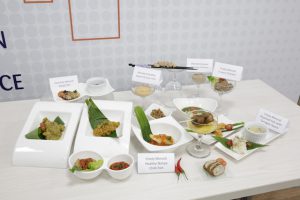Asian meals for those with dysphagia
Changi General Hospital is working with Health Food Matters to produce and market meals in the Asia-Pacific region.
The first ready-to-eat, texture-modified meals in local flavours have been created by Changi General Hospital (CGH). These meals are suitable for people with swallowing difficulties (dysphagia) as well as the elderly who prefer soft meals. The meals will be produced and marketed under a licensing agreement signed recently between CGH and local specialist nutrition company Health Food Matters (HFM).
CGH’s meals fill a gap in the market for meals that appeal to the local palate while meeting the dietary needs of those with dysphagia. These meals are available in three textures – finely minced, coarsely minced or blended – to ease swallowing. Fourteen recipes are available, including familiar dishes such as Malay-style dishes like seafood otak and kicap fish and Chinese-style dishes like five-spice chicken. There are also Western-style dishes such as chicken patty with orange cheese sauce and poached fish fillet with tarragon sauce.
These meals are nutritionally-balanced and ready-to-eat, thus helping to lighten the preparation work by caregivers. The meals are also suitable for those who have diabetes and hypertension as the sodium, fat and cholesterol content are minimised.
“Dysphagia is a common problem among the elderly and a growing health concern in Singapore due to the rapidly ageing population. We are pleased to have found a like-minded partner in Health Food Matters to produce these meals for a wider audience, enabling us to continue focusing on research and development in dietetics to meet patients’ needs,” said Magdalin Cheong, deputy director, Department of Food Services, CGH.
Terms of agreement
Under the terms of the agreement between CGH and HFM, the hospital will provide formulas and recipes for its meals to HFM, which will in turn produce, market and distribute the meals in Singapore, Japan, New Zealand and Australia. According to CGH, the meals will be retailed through HFM’s retail channels which is its website at the moment. The hospital said it is still working out with HFM the pricing of the meals.
Shared Grace Gan, co-founder of HFM, of this agreement, “With our strengths in specialised nutrition, we hope to help people with dysphagia rediscover the joy of eating through CGH’s ready-to-eat, texture-modified meals. Our manufacturing facility in Woodlands is currently being renovated to prepare for the production of the meals in early 2017.”
| SIDEBOX: What is dysphagia?
Dysphagia or difficulty swallowing is prevalent among older adults. It occurs as a result of age-related loss of musculature and function involved in swallowing and/or because of neurological, degenerative, respiratory and musculoskeletal diseases. It affects up to 68 percent of elderly nursing home residents, up to 30 percent of elderly admitted to hospital, and up to 64 percent of patients after stroke. People with dysphagia must consume food prepared with specific textures to enable safe eating. These textures are prescribed by speech therapists to suit each person’s level of dysphagia. Texture-modified meals prepared by caregivers may present with the following issues:
|



0 Comments